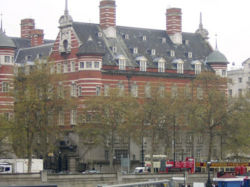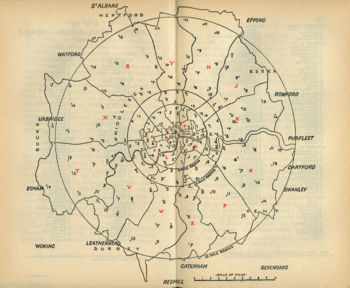Scotland Yard: Difference between revisions
imported>Russell Potter |
imported>Russell Potter |
||
| Line 12: | Line 12: | ||
This system of lettered divisions was maintained until 1985, when the Newman Restructuting Plan replaced them with a system of 67 divisions and subdivisions, and further refined to 62 divisions in 1995. The entire divisional system, however, was abandoned in 1999 when it was replaced by the Borough Policing model. | This system of lettered divisions was maintained until 1985, when the Newman Restructuting Plan replaced them with a system of 67 divisions and subdivisions, and further refined to 62 divisions in 1995. The entire divisional system, however, was abandoned in 1999 when it was replaced by the Borough Policing model. | ||
== | ==Notable Figures Associated with Scotland Yard== | ||
*Inspector [[Charles Frederick Field]] | *Inspector [[Charles Frederick Field]] | ||
*Chief Constable [[Frederick Porter Wensley]] | *Chief Constable [[Frederick Porter Wensley]] | ||
Revision as of 16:05, 28 April 2007
Scotland Yard is the traditional name of the headquarters of the London Metropolitan Police. The name derives from a small, enclosed field in the Whitehall district of London, which was adjacent to the force's original headquarters. The name has remained through subsequent moves, first in 1890 to "New" Scotland Yard, an ornate brick building in the Italian Revival style designed by Norman Shaw on the Victoria Embankment, and then in 1967 to the present New Scotland Yard on Victoria Street in Westminster. Because the original Detective Division of the Metropolitan Police had its offices in the rear of Whitehall Place in the first of these buildings, the name has been especially associated with the department's detective branch, known since 1878 as the Criminal Investigation Department or CID, but the phrase "Scotland Yard" has also been applied to the Metropolitan Police as a whole.
History
Scotland Yard was founded as the headquarters of the Metropolitan Police by Sir Robert Peel. It opened on 29 September 1829, housing the two commissioners and their administrative staffs. It was not (and has never been) a police station in the usual sense, since each division of the police operates its own local stations, but has housed certain centralized units, such as the CID and theSpecial Branch, which operate with a degree of independence in their specialized areas.
Metropolitan Police District and Divisions
It is not widely realized outside of Britain, but the one area that the Metropolitan Police District has always excluded is the City of London, which has its own entirely separate police force. The original district was divided further into seventeen divisions, each represented by a letter of the alphabet, as follows: A - Westminster; B - Chelsea; C - Mayfair and Soho; D - Marylebone; E - Holborn; F - Kensington; G - Kings Cross; H - Stepney; K - West Ham; L - Lambeth; M - Southwark; N - Islington; P - Peckham; R - Greenwich; S - Hampstead; T - Hammersmith and V - Wandsworth. Three new divisions were added in 1865: W - Clapham; X - Willesden and Y - Holloway, and lastly J Division (Bethnal Green) was created in 1886, for a total of twenty-one divisions until Z Division (Croydon) was added in 1921. The Thames River Police had no divisional letter, but had the entirety of the Thames as its "beat". The diagram at right indicates all the division boundaries as they stood in 1929, with numbered indications for each Police Station.
This system of lettered divisions was maintained until 1985, when the Newman Restructuting Plan replaced them with a system of 67 divisions and subdivisions, and further refined to 62 divisions in 1995. The entire divisional system, however, was abandoned in 1999 when it was replaced by the Borough Policing model.
Notable Figures Associated with Scotland Yard
- Inspector Charles Frederick Field
- Chief Constable Frederick Porter Wensley
- Chief Inspector Lilian Wyles
See Also
References
- The Official Encyclopedia of Scotland Yard, by Martin Fido and Keith Skinner (London: Virgin Books, 1999)

